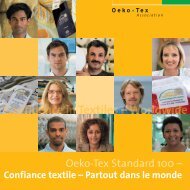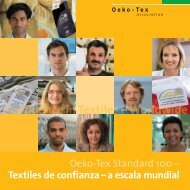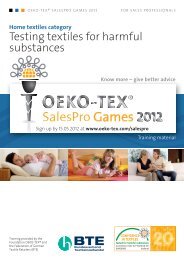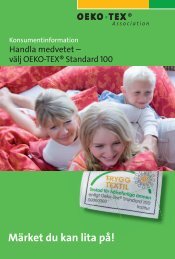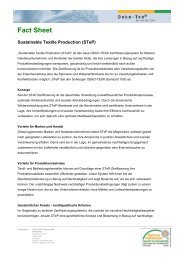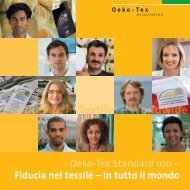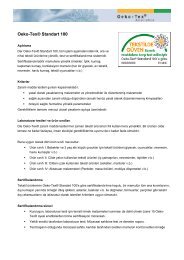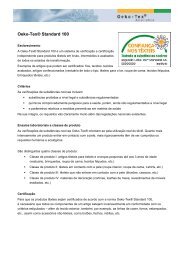OETS 100 Shop Smart EN - Oeko-Tex
OETS 100 Shop Smart EN - Oeko-Tex
OETS 100 Shop Smart EN - Oeko-Tex
You also want an ePaper? Increase the reach of your titles
YUMPU automatically turns print PDFs into web optimized ePapers that Google loves.
Consumer information<br />
<strong>Shop</strong> smart – look for the<br />
OEKO-TEX® Standard <strong>100</strong> label<br />
It’s a symbol you can rely on!
Page 2<br />
Safety certainly<br />
feels good<br />
We are in close contact with<br />
textiles throughout our lives –<br />
day and night. We wear them<br />
next to our skin, sleep in textile<br />
products, dry ourselves with<br />
them, use them to decorate our<br />
homes and for much more. Isn’t<br />
it good to know that textiles –<br />
whether they’re made of natural<br />
or synthetic material – are free<br />
of substances that could harm<br />
our health?<br />
When you’re out shopping,<br />
look for the sign of safety and<br />
transparency, the label that says<br />
“Confidence in <strong>Tex</strong>tiles –<br />
tested for harmful substances<br />
according to OEKO-TEX®<br />
Standard <strong>100</strong>”.<br />
It’s the sign that a product has<br />
successfully passed tests based<br />
on more than <strong>100</strong> health-relevant<br />
parameters carried out by the<br />
independent testing institutes<br />
of the OEKO-TEX® Association.<br />
This standard was developed<br />
in 1992 in order to ensure a<br />
comprehensive level of safety<br />
for all levels of production –<br />
from the manufacture of yarns<br />
to the finished product, including<br />
accessories such as buttons and<br />
zips.<br />
<strong>Tex</strong>tiles bearing the OEKO-TEX®<br />
label meet high human ecological<br />
requirements.<br />
Our principle is: The more<br />
intense contact a product has<br />
with the skin, the stricter the<br />
criteria we set for it.<br />
You can count<br />
on it!<br />
Page 3
Page 4<br />
This language<br />
is understood all<br />
over the world<br />
It doesn’t matter where you<br />
buy textiles or where they’ve<br />
been made: All products marked<br />
with the OEKO-TEX® label are<br />
safe because they’re free of any<br />
amounts of harmful substances.<br />
We ensure this with OEKO-TEX®<br />
criteria that are uniform worldwide<br />
and which all member<br />
institutes’ laboratories are<br />
obliged to use to systematically<br />
test textiles.<br />
More than 9,500 manufacturers<br />
in over 80 countries have their<br />
products tested and certified<br />
according to the high testing<br />
standards of the International<br />
OEKO-TEX® Association using<br />
state-of-the-art laboratory<br />
technology and scientificallybased<br />
parameters for harmful<br />
substances.<br />
For your safety and<br />
certainty.<br />
You can find (branded) textiles<br />
marked with the OEKO-TEX® label<br />
all over the world. They‘re available in<br />
nearly every type of retail outlet – in<br />
speciality shops, department stores,<br />
mail order catalogues and even at<br />
discounters.<br />
Page 5
Page 6<br />
Always a step ahead<br />
The OEKO-TEX® Association has<br />
always made its aim to be a<br />
bit ahead of times. That’s why<br />
testing for harmful substances<br />
is only part of what it does.<br />
Since it was established,<br />
OEKO-TEX® has always occupied<br />
a pre-eminent role in continually<br />
setting new benchmarks for the<br />
industry by pursuing scientific<br />
research and furthering the<br />
development of testing processes.<br />
Of course the tests for harmful<br />
substances include legally banned<br />
and regulated substances, e.g.<br />
specific carcinogenic chemicals<br />
derived from AZO dyes.<br />
Beyond that, tests are also made<br />
for chemicals known to pose a<br />
threat to health. For years now,<br />
OEKO-TEX® has, for example,<br />
ruled out the use of allergenic dyes<br />
even though legal limits have yet<br />
to be placed on them.<br />
These also include parameters<br />
such as good colourfastness and<br />
skin-friendly pH values that are<br />
part of sound health care.<br />
This is where you can find a detailed catalogue of our testing criteria:<br />
www. oeko-tex.com/limitvalues<br />
Page 7
Page 8<br />
4 Product classes<br />
OEKO-TEX® tests for harmful<br />
substances are always orientated<br />
towards how the product is<br />
actually used.<br />
Delicate items worn next to<br />
the skin, such as baby clothes,<br />
underwear or lingerie, must as<br />
a result meet tougher standards<br />
than textiles that have little or<br />
no contact with the skin such<br />
as, for example, fabrics used for<br />
decorating.<br />
Accordingly, OEKO-TEX® Standard<br />
<strong>100</strong> has four product classes.<br />
Product Class I<br />
<strong>Tex</strong>tiles and textile toys for babies<br />
and small children up to the age<br />
of three: underwear, romper suits,<br />
bed linen, bedding, soft toys, etc.<br />
Product Class II<br />
<strong>Tex</strong>tiles for which large part of<br />
their surface is in direct contact<br />
with the skin: underwear, shirts,<br />
blouses, socks and stockings, bed<br />
linens, terry goods etc.<br />
Product Class III<br />
<strong>Tex</strong>tiles that do not come into<br />
contact with the skin or only have<br />
a small part of their surface in<br />
contact with the skin: jackets,<br />
coats, items for use outdoors, etc.<br />
Product Class IV<br />
Materials for interior decorating<br />
and decorative purposes: table<br />
linen, curtains, upholstery etc.<br />
Page 9
Page 10<br />
Tested quality –<br />
something you can<br />
count on!<br />
The OEKO-TEX® label is proof<br />
positive for you when it’s a<br />
matter of finding textiles that<br />
are safe from a human ecological<br />
standpoint.<br />
Even after laboratory testing has<br />
been carried out by the testing<br />
institutes and certificates have<br />
been issued to manufacturers,<br />
annual monitoring tests are<br />
also performed at the point-ofsale<br />
for more than 15% of the<br />
certificates issued.<br />
In addition, the OEKO-TEX®<br />
Association also carries out onsite<br />
monitoring at OEKO-TEX®<br />
certified companies.<br />
Independent auditors go to the<br />
firm to assess whether quality<br />
assurance there meets OEKO-<br />
TEX® requirements.<br />
www. oeko-tex. com/validity<br />
Page 11
Page 12<br />
Labelling<br />
All or nothing:<br />
the modular<br />
principle<br />
Products may only bear the<br />
OEKO-TEX® label if all components<br />
meet without exception the<br />
requirements of the preestablished<br />
testing criteria.<br />
Thus, along with the fabric and<br />
sewing thread, non-textile<br />
accessories, such as buttons,<br />
zips, lining, and stuffing etc.,<br />
are also tested for concentrations<br />
of harmful substances that<br />
could pose a threat to health.<br />
After all, the whole is only as<br />
good as the sum of its parts.<br />
Sewing thread<br />
Press studs<br />
Fabrics<br />
Jeans<br />
Zips<br />
You can have confidence<br />
in the OEKO-TEX® label, too!<br />
All the firms taking part – from<br />
yarn makers to weavers, knitters,<br />
and finishers right through to<br />
garment manufacturers and<br />
retail shops – pay attention to<br />
the requirements of the<br />
OEKO-TEX® Standard <strong>100</strong> in<br />
their daily production routines<br />
and earn your “Confidence in<br />
<strong>Tex</strong>tiles” through commitment<br />
to and implementation of those<br />
demands.<br />
With 95,000 certificates issued<br />
up to now, the label “Confidence<br />
in <strong>Tex</strong>tiles” is world-wide the<br />
best-known and most widespread<br />
test label for textiles that have<br />
been tested for harmful<br />
substances.<br />
Every article that’s been successfully<br />
test number. When you’re out shoppi<br />
on the label.<br />
tested receives a certificate with a<br />
ng, look for items with a test number<br />
Page 13
Page 14<br />
Baby underwear, baby<br />
clothes, textile toys and<br />
other products for babies<br />
OEKO-TEX® subjects textiles<br />
that come into contact with<br />
the sensitive skin of babies<br />
and children to the toughest<br />
requirements of all. That’s why<br />
all OEKO-TEX® certified baby<br />
items must be dyed so their<br />
colours are resistant to saliva.<br />
Formaldehyde is banned.<br />
What’s even nicer is that many<br />
manufacturers comply with<br />
these special requirements for<br />
textiles that aren’t only<br />
intended for small children or<br />
infants!<br />
<strong>Oeko</strong>-<strong>Tex</strong>® Standard <strong>100</strong>:<br />
Rest assured that particularly<br />
items for babies have passed<br />
the toughest of testing<br />
requirements.<br />
Terry Goods<br />
Whether it’s during daily<br />
hygiene, at the gym, in the<br />
sauna, or on the road: Terry<br />
products such as bath and<br />
hand towels frequently come<br />
into intense contact with the<br />
skin. That’s why it’s important<br />
to pay attention to ensure<br />
these products don’t contain<br />
any substances that could<br />
pose a threat to health.<br />
Terry products marked with<br />
the OEKO-TEX® label meet this<br />
demand, and what’s more,<br />
they have good colour-fast<br />
ratings.<br />
Bedding and Bed Linen<br />
These textiles are tested<br />
according to OEKO-TEX®<br />
requirements for textiles<br />
used close to the skin.<br />
Mattresses, pillows and<br />
duvets bearing the OEKO-TEX®<br />
label are free of concentrations<br />
of harmful substances that<br />
could pose a threat to health.<br />
After all, we spend about a<br />
third of our lives in bed. It’s a<br />
time that should naturally be<br />
as revitalising and healthy as<br />
possible.<br />
Large volume products made<br />
of foam are also subjected to<br />
OEKO-TEX® laboratory tests,<br />
where they face additional<br />
emissions testing to rule<br />
out the release of harmful<br />
substances into the air.<br />
Curtains, decorating<br />
fabrics and table linen<br />
Some products we use to<br />
decorate our homes have large<br />
surface areas and can have a<br />
significant influence on indoor<br />
air quality.<br />
Whether they’re curtains, or<br />
it’s a table cloth, decorating<br />
fabric or upholstery material,<br />
or textile wall or floor coverings:<br />
You can be certain again –<br />
there’s no trace odours from<br />
home textiles that carry the<br />
OEKO-TEX® label.<br />
Please use the internet to find out more about certified pro ducts and brand-name items:<br />
www.oeko- tex.com/products and www.oeko-tex.com/brands<br />
Page 15
Page 16<br />
Outerwear<br />
Fashion is an important means<br />
of expressing your individuality<br />
on the job, during leisure time<br />
and at play.<br />
Look for the OEKO-TEX® label<br />
when you’re shopping to make<br />
sure you choose the items that<br />
are BOTH good for your health<br />
as well as your appearance.<br />
From t-shirts to tuxedos, caps<br />
to socks, and cycling shorts to<br />
a football strip: The OEKO-<br />
TEX® label allows you to find<br />
textiles that have been tested<br />
for harmful substances at<br />
stores in your area, so you can<br />
shop smart.<br />
Daywear and Nightwear<br />
In consideration of their daily<br />
use, underwear, lingerie,<br />
sleepwear and nightshirts are<br />
in principle tested and certified<br />
according to the requirements<br />
for OEKO-TEX® Product Class II.<br />
From a health standpoint,<br />
body- wear marked with the<br />
OEKO-TEX® label offers unlimited<br />
wearing pleasure and a<br />
skin-friendly pH value.<br />
Medical Products<br />
Whether it’s a bandage or a<br />
pair of compression stockings,<br />
orthopaedic undergarments,<br />
diabetic socks, incontinence aids<br />
or clothing for neurodermatitis<br />
sufferers, medical products are<br />
highly functional and make an<br />
important contribution to<br />
increasing our daily sense of<br />
well-being and quality of life.<br />
Particularly for people with sensitive<br />
skin, the safety of textiles used for<br />
medical products is of immense<br />
importance. A leading medical<br />
service organisation of Germany’s<br />
public health insurance funds,<br />
MDS, has demanded that these<br />
items be found free of substances<br />
that could be harmful to health.<br />
Workwear and<br />
Protective Clothing<br />
In order to meet general and<br />
specific protective specifications<br />
for workwear, heavy technical<br />
demands are placed on textile<br />
constructions and many types<br />
of modern, sophisticated<br />
combinations of materials and<br />
high-tech finishings are used.<br />
<strong>Tex</strong>tile safety is – along with<br />
good wearing comfort –<br />
particularly important because<br />
workwear must be accepted by<br />
the wearer for it actually to be<br />
used.<br />
As an independent testing label<br />
for textiles that have been tested<br />
for harmful substances,<br />
OEKO-TEX® Standard <strong>100</strong> meets<br />
this demand.<br />
Ask about it: your specialist retailer will be happy to tell you more about products marked with the OEKO-TEX® label!<br />
Page 17
Page 18<br />
Sustainable laundering<br />
– there’s so much you,<br />
yourself, can do!<br />
Do a little extra for your<br />
health – use textiles that<br />
have been tested for harmful<br />
substances.<br />
The OEKO-TEX® Testing Association<br />
uses complex tests and painstaking<br />
monitoring to ensure products<br />
marked with the OEKO-TEX® label<br />
are unobjectionable in human<br />
ecological terms.<br />
If you would like to not only do<br />
something to protect your health,<br />
but to extend the life of your<br />
textiles, there’s a great deal you<br />
can do simply through proper care.<br />
Your job to ensure the best<br />
value-maintenance of your<br />
textiles is:<br />
Please be certain to follow laundry<br />
detergent amount recommendations<br />
and be aware of the hardness of<br />
the water at your home.<br />
Remember to comply with the<br />
recommendations on the textile’s<br />
care instructions label.<br />
Sustainable laundering<br />
<strong>Tex</strong>tile care<br />
To protect delicate fabrics, it helps<br />
to turn the garment inside out.<br />
Base the amount of detergent<br />
on the degree of soiling of the<br />
laundry, and please sort<br />
according to colour (lights,<br />
medium, darks). That should<br />
give you optimal results.<br />
Save energy – reduce CO 2<br />
emissions for a better<br />
climate<br />
One way to cut down on energy<br />
costs is to reduce laundering<br />
temperature (e.g. from 60 °C to<br />
40 °C). This can also reduce the<br />
CO 2<br />
-emissions of a two-person<br />
household by as much as 33 kg<br />
annually.<br />
But drying is where you can really<br />
save, and help the environment –<br />
e.g. count on fine weather, leave<br />
the dryer alone and hang up the<br />
laundry in the fresh air. Dryers use<br />
much more energy than washing<br />
machines.<br />
Page 19
International <strong>Oeko</strong>-<strong>Tex</strong>®<br />
Association | Secretariat<br />
Gotthardstrasse 61<br />
Postfach 2156<br />
CH-8027 Zürich<br />
Tel. +41 44 206 42 35<br />
Fax +41 44 206 42 51<br />
info@oeko-tex.com<br />
www.oeko-tex.com<br />
OEKO-TEX® Foundation GmbH<br />
Kaiserstraße 39<br />
D-60329 Frankfurt / Main<br />
Tel. +49 69 4003408-0<br />
Fax +49 69 4003408-299<br />
info@certification-oekotex.com<br />
www.oeko-tex.com<br />
Area for company stamp




